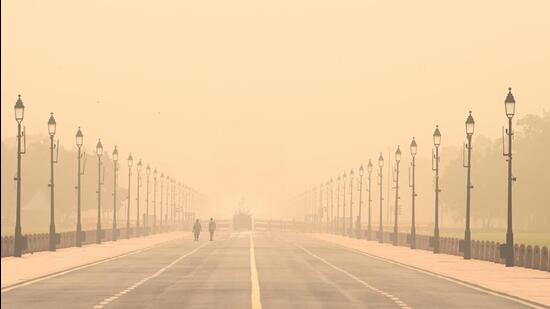Our Terms & Conditions | Our Privacy Policy
Delhi: For IMD, 3rd time is not a charm with forecast miss | Latest News Delhi
Late Wednesday night, a dense haze of dust blanketed Delhi without warning, choking the city through the night and into Thursday morning. The sudden intrusion of grit-laden air, which lingered until almost noon, brought visibility down and residents gasping for breath — yet again catching both citizens and authorities off guard.
Dust on Kartavya Path in New Delhi on Thursday morning. (Vipin Kumar/HT Photo)
At the centre of the storm, once more, is the India Meteorological Department (IMD), whose forecast had predicted only “thundery development” and winds of 15-25 km/hr, gusting up to 35 km/hr. Nowhere did it mention the scale or severity of the dust that would roll in from Rajasthan’s Thar desert.
This marked the third time this month that Delhi’s weather turned volatile with no meaningful alert from the country’s official weather agency.
Madhavan Rajeevan, former secretary at the Union ministry of earth sciences, said dust storms are typically easier to anticipate than localised thunderstorms. “Thunderstorms can emerge quickly over small regions, making them harder to model. But dust storms that span large distances can and should be predicted with better tools and interpretation,” he said.
The haze on Wednesday was not a standalone event. On May 12, an intense thunderstorm lashed Delhi, flooding roads and neighbourhoods with 77mm of rain in just 24 hours—the second-highest such spell in May in recorded history. That day, IMD’s forecast only mentioned “very light rain or drizzle.”
Just over a week earlier, on May 13, a sudden storm had swept through Delhi with rain and gusts reaching 60 km/hr. The day’s forecast, however, spoke only of a warm afternoon with light surface winds.
Mahesh Palawat, vice president at Skymet Weather, said that while pre-monsoon instability poses forecasting challenges, large-scale dust or rain events should not be missed. “Local spells are unpredictable, yes. But this wasn’t that. The dust travelled a long distance and covered wide ground. That’s exactly what models are built to track.”
Despite criticism, IMD officials insisted they had done their job. “It’s not accurate to say there was no forecast. We had predicted thundery development and gusty winds for Wednesday night,” said RK Jenamani, senior scientist at IMD. He argued that the dust event did not meet the formal criteria for a dust storm warning under IMD protocols.
According to the IMD, a “light duststorm” requires gusts up to 40 km/hr and visibility below 1,000 metres; a “moderate” one involves 41–61 km/hr winds and visibility between 200–500 metres; a “severe” storm drops visibility below 200 metres with wind speeds above 62 km/hr. IMD spokesperson Soma Sen Roy said that visibility in Delhi stayed around 1,200 metres, and thus, no coloured alert was warranted.
But critics weren’t convinced. Ashwary Tiwari, an amateur meteorologist who tracks storms via his IndiaMetSky account, said the storm originated on the outskirts of Pakistan and moved steadily eastward, covering vast areas of Rajasthan before reaching Delhi. “There was enough time to anticipate and issue a specific advisory about the dust levels,” he said. “Models were showing the system’s trajectory. Even if its intensity fluctuated, the volume of dust and its likely arrival should’ve been factored in.”
Such lapses are not new. Last year, IMD came under fire on June 28 when a massive and unpredicted storm dumped 91mm of rain on Delhi in just an hour, crippling city infrastructure. With over 228mm in a 24-hour span, the event was later described by officials as “almost a cloudburst.” IMD’s forecast? “Light to moderate” rain.
As the haze lifted and life resumed on Thursday afternoon, experts said it was yet another reminder that Delhi, already one of the most polluted capitals in the world, needs more accurate and timely weather alerts—especially as climate volatility grows.
“Forecasting has improved, but interpretation has not kept pace,” said Rajeevan. “We’re still often responding to yesterday’s weather while today chokes us.”
Images are for reference only.Images and contents gathered automatic from google or 3rd party sources.All rights on the images and contents are with their legal original owners.



Comments are closed.